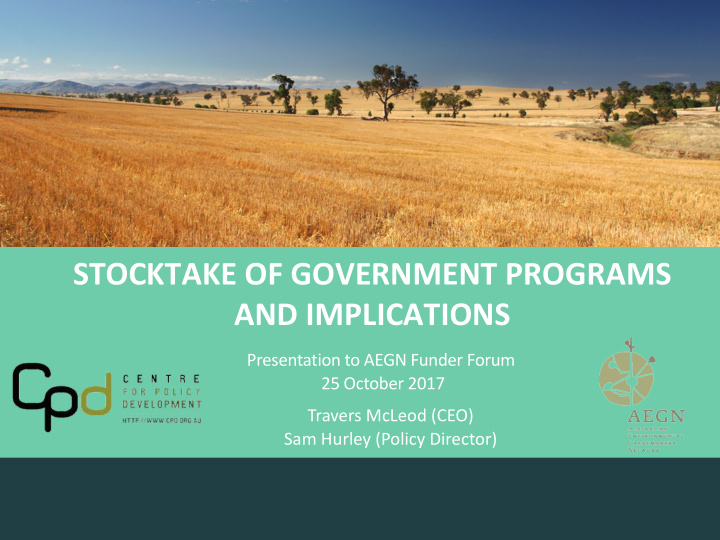



STOCKTAKE OF GOVERNMENT PROGRAMS AND IMPLICATIONS Presentation to AEGN Funder Forum 25 October 2017 Travers McLeod (CEO) Sam Hurley (Policy Director)
CPD's investigation revealed fragmentation and inconsistency Opportunities CPD findings • Out of date and unclear information • Coordination: research and advocacy Fragmentation and • Fragmented policy rationales and to support policy consistency and complexity confused priorities dialogue across sectors • Integration: drive better food systems Overarching • Trade and investment lens policy by building connections to other ‘exports’ focus continues to dominate policy priorities (e.g. climate) Strong institutions • Connection: join local and regional • Legacy of Landcare and other efforts projects and leaders up with global and engagement • New focus on partnerships networks and ideas
Context: complexity of the food system and policy interactions Source: Ripe for Change 2016
Food systems issues cut across multiple policy areas Source: Australian Government National Food Plan 2013
Policy priorities can change rapidly To the Agricultural Competitiveness From the National Food Plan (2013)… White Paper (2015) Key announcements made in 2013 either scrapped or discontinued by 2015… • 5-yearly State of the Food System reports • Australian Council on Food • Community Food Grants program Source: http://agriculture.gov.au/style%20library/images/daff/__data/assets/pdffile/0011/2293328/national-food-plan-white-paper.pdf; http://agwhitepaper.agriculture.gov.au/SiteCollectionDocuments/ag-competitiveness-white-paper.pdf
Our stocktake and the Ripe for Change strategic priorities • Hundreds of programs, grants and initiatives across multiple departments and levels of government • Full details available: www.cpd.org.au/stocktake Healthy natural systems Viable enterprises Overwhelming focus is issues for large • Major programs targeting on-and-off farm • businesses and export markets resource management and biodiversity Infrastructure and connectivity • Trade promotion and facilitation • Likelihood of additional effort under new • Sustainability branding • policy frameworks Victoria Climate Change Strategy • Some support and facilitation through R&D • NLP Phase 2 (from July 2018) • and transmission Health equity access Engaged & galvanised movements Mostly outside scope of our stocktake Strong foundations from Landcare and • • highly engaged NGO/philanthropy National Food Plan included community • initiatives and food security based goals for New forms of partnerships through NLP • disadvantaged groups Phase 2 e.g. Smart Farming Partnerships VicHealth – established history of food • security initiatives
There are opportunities as well as challenges Strengths to build on Established higher expectations and capabilities for land managers • Empowered and engaged local actors • Integrated view of concepts and goals • Well developed regional networks for rolling out changes in policy/practice • Supportive trends More engaged consumers and communities around food issues • Better techniques and technology for measuring linkages • Growing importance of social license and sustainable development • New opportunities (even within old paradigms) Sustained focus on policy issues closely connected with ag. and food systems • Policies and strategies in a state of flux and redevelopment • e.g, Victoria’s climate change adaptation framework o e.g, Regional partnerships model within NLP Phase 2 o
For discussion: potential priorities Priority 1 – Co-ordination between government, business, philanthropy and the sector Imperative for independent research and advocacy – combined with trusted convening power – to drive policy consistency and co-ordinate dialogue across sectors and stakeholders. Priority 2 – Integration of existing effort with momentum elsewhere (climate-risk, SDGs) Show how food systems policy and projects can support other priorities for government and industry (e.g. it is often siloed and set apart from climate risk/opportunity and disclosure, and not understood alongside whole of government objectives like the Sustainable Development Goals). Priority 3 – Connecting local efforts with global research and advocacy on what works Best and ‘next’ practice locally can maximise its influence nationally if it teams up globally with recognised networks and well-supported projects, respected leaders and ideas.
Food systems, agriculture and climate – Project Drawdown
Food, agriculture and the Sustainable Development Goals
Some proposals for next steps Coordination High-level roundtables to connect philanthropists, ministers, Key stakeholder policy leaders, farmers, investors and businesses to consider dialogue towards an opportunities to build a more coherent and outcomes- agreed agenda focussed policy architecture for sustainable food systems Integration New research and thought leadership on role of SDGs in Linking food Australian business, policy and philanthropy (including CPD systems to other work on sustainability-related decision making and disclosure policy responses by companies, investors and public authorities) Connection Providing local innovators with access to global networks and expertise (local tour, consultations and presentation of cutting Connect global edge research) ( Katharine Wilkinson from Project goals to local issues Drawdown, Oxford’s Food Climate Research Network )
Recommend
More recommend